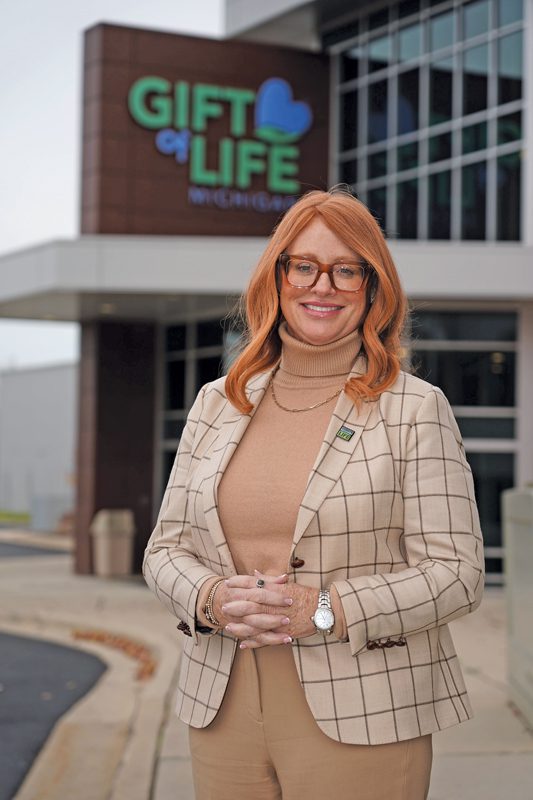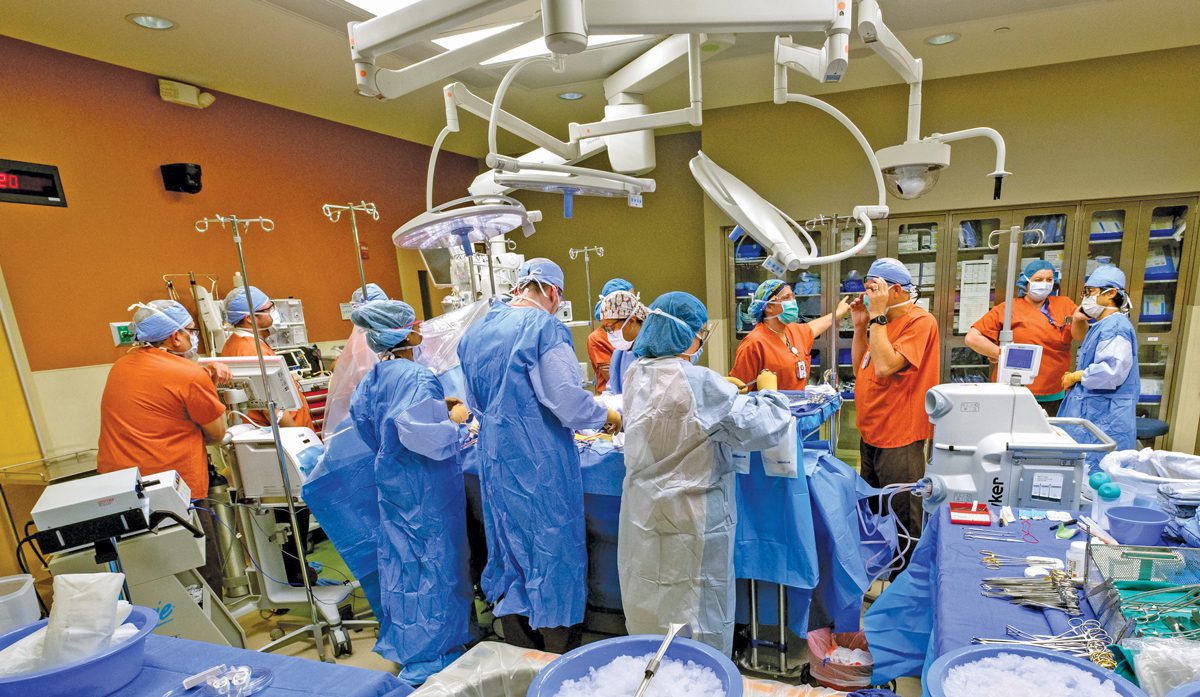
“It feels like the whole deck is being wiped clean, and a new system is being created,” Dils says of the reorganization. “We all are concerned that at the end of the day, the system has to keep running.” But she’s hopeful that the changes will mean that “when you need an organ, it’ll be there for you.” | Photo by J. Adrian Wylie
Dorrie Dils’ first job as a nurse was in an intensive care unit in Ohio. It was “a very busy Level 1 trauma center in Columbus,” she recalls. “When you work in a busy ICU like that, death is a part of your daily routine.”
But for the survivors, she realized, some deaths felt better than others: When the person was an organ donor, the loss of life led to the gift of life.
“Because while the death is awful and tragic, and the family is grieving—the fact that their loved one is going to be able to go on and save someone else became so powerful,” she says. “I found the whole process to be really inspiring.”
She also thought about “all of the people who are waiting for a transplant who get that call that their life is going to be saved, and all the people that that touches on the other end. It was just a really unique area of medicine.”
So Dils left nursing to work as a donor coordinator at Lifeline of Ohio, the organ procurement agency that made those transplants possible. “I walked in and I never looked back.”
She became president and CEO of Gift of Life Michigan in 2016. At the time, she says, the Ann Arbor–based agency was “averaging about 280 organ donors a year.” The number has since more than doubled, to 578 last year.
“These are 578 individuals and their families who, at the end of their life, chose to save the life of someone else,” she says.
Dils, fifty-nine, grew up “very modestly” in West Jefferson, Ohio. Her parents married young and never went to college; neither did her younger brothers. (One became a firefighter and the other works for the city of Columbus.)
But about the time she was in middle school, her father was hurt, and she helped care for him. Soon, “everybody was saying, ‘Dorrie’s going to be a nurse.’” She worked as a patient care assistant while earning her BSN, then as a nurse, and then as a donor coordinator at Lifeline.
“Back then we did everything,” she recalls. “One day I’d be in the OR with the donor, and the next day I would be having a meeting with the hospital CEO to talk about their donation program.
“It was very broad. But what I learned during that time was that I had skills on [the administrative] side, too.”
She got a master’s degree in health administration and worked her way up to Lifeline’s chief clinical officer. “I always thought I’d replace the CEO there,” she says. “But he was not ready to retire, and I was turning fifty.”
Dils started looking around and got a CEO offer from an agency in Miami. But then Gift of Life Michigan announced that its CEO was leaving. “I reached out to some colleagues who I knew were on the board here, and they were very encouraging,” she says. “I turned down that [Miami] offer with a hope and a prayer” and won the Michigan job.
Gift of Life had about 200 employees at the time. In her first year, it added seventy more. She says her board agreed that “if needed, we would dip into reserves to support the growth. However, with slight adjustments to our reimbursements for organs, we exceeded goals and did not have to use reserves. The following years’ staff growth was less, but we’ve continued to grow.”
With nearly 400 people now, they’re doing a better job reaching the families of prospective donors: people who are dying but whose organs could live on to save other lives.
“Michigan’s a big state, and we have hospitals all over the state, and a potential donor can happen in any one of them,” Dils says. With a smaller staff, “we kind of followed the case from afar, and should the patient progress to the point where donation is an option, then we [would] step in and talk to the family. And we weren’t always able to be there when that moment came.
“Sometimes families were having to wait for us to get there, or we were having to talk with them over the phone because they were at the hospital, and we weren’t.” With more staff, they’re now more responsive.
When Dils started, donation coordinators “did everything from answer the phone when the initial referral came in, to responding, to talking with the families, to clinically managing the donor, to going to the operating room.” But they’ve since learned that “the people who are really good at sitting down with the donor family and talking about the option of donation may not have the same skill set as the people who are doing the clinical management, for example. So we’ve really specialized a lot of those roles so that we have the right person doing the right thing at the right time.
“We use a phrase, ‘We meet families where they are.’ We do a lot of training with our staff about cultural sensitivities and making sure that they really, as best they can, get to know the situation and the family before they dive into the conversation.
“We’re trying to learn things about the person. Is this something that they would have wanted to do? No two conversations are the same. While there are some specific things that we have to share with the family, the conversations are very nuanced.”
They aren’t just signing up more donors—they’re doing more with each donation. “A lot of new innovation and technology [is] coming into play that is allowing us to keep organs, once they’ve been recovered, on machine preservation and evaluate them, and in some cases even rehabilitate them,” Dils says.
Kidneys have long been put on pumps that “can test the pressures and test how we believe it’s going to function when it goes into the recipient.” But now, “there are devices for hearts and lungs, too—preservation machines.” In August, Gift of Life started using a new one that takes “a liver that may not look so great initially” and “makes it better, so that it can actually be transplanted.”
Gift of Life doesn’t own the machine. “As you can imagine,” Dils says, “the technology is very, very expensive.” When needed, the manufacturer brings it to their on-site donor care center. Some brain-dead patients also are brought there for organ donation. “But the organs are then transported to a transplant hospital where the recipient is,” Dils says. “We don’t do any transplants in this building.”
Last year, 578 donors enabled 1,372 organ transplants, including 744 kidneys, 302 livers, 163 lungs, and 131 hearts. They also provided 1,858 gifts of tissue, such as tendons, skin, and bones. Through their Ann Arbor partner Eversight, another 1,463 Michiganians received sight-restoring cornea transplants.
Nevertheless, at the start of October, 2,111 people were waiting for kidneys, 172 for livers, 115 for hearts, and sixty-seven for lungs. Even with the increase in donations, ninety-seven Michigan residents died last year while waiting for a transplant.
So Gift of Life is also working to expand the state’s organ donor registry. About 4.5 million people, 57 percent of the state’s population, are already signed to be donors after their deaths, but Gift of Life is always looking for more—and facing some obstacles in doing so.
“All the states around us have a requirement for ninth or tenth graders to get education in the classroom about organ, tissue, and eye donation,” Dils says. “And Michigan does not have that law.” It does require education during driver’s training, but, oddly, students are asked if they want to sign up before getting the education.
“The second issue is that fewer and fewer teens are taking driver’s ed,” Dils says. “Driver’s education is expensive, and it’s not offered in most schools,” so many young people are waiting till they’re eighteen, when they get a license just by passing a test. “So we don’t have in our state a really good way to educate our new drivers.”
Gift of Life has been trying to get a bill passed to mandate donor education in high schools, Dils says, “but the public school system is very opposed to mandates, and so we’re trying to figure out how to best get that done.” In the meantime, they’ve started a voluntary program using their own staff. It’s called All of Us, and Gift of Life board member Pamela Sawhney and her husband Krishna have pledged $125,000 over five years to support it.
“The students can put on gloves and hold a heart and a liver, and it’s the best anatomy lesson they’ll ever see,” Dils says. “It’s really, really cool.” Students also breathe through straws to experience “what it feels like to have pulmonary disease and lung disease where you can’t breathe, and they put on these glasses that emulate what it’s like to have vision problems.” Senior PR specialist Melissa Foster says the program has been presented at Huron, Pioneer, and Skyline high schools.
Last year, a bill they advocated made Michigan the first state in the country to add a checkbox for organ donation to its income tax form. “We really didn’t have much time to get the word out” before tax time, Dils says, but Gift of Life still gained more than 13,000 new registrations. They have a “whole strategy” for reaching tax preparers this year, she says, “so there’s still a lot of opportunity there.”

Surgeons retrieve organs and tissue at Gift of Life’s Donor Care Center on Research Park Dr. New technology enables them to preserve and evaluate recovered organs, Dils says, “and in some cases even rehabilitate them.” | Courtesy of Gift of Life
In September, a former worker at Kentucky’s organ procurement agency told a congressional committee that a supposedly brain-dead patient showed signs of life while being transported to an operating room—and that a colleague was pressured to proceed with the donation anyway. It was halted, and three years later, the patient is still alive. But within two weeks, seventy people contacted Gift of Life Michigan to remove their names from the donor list.
Because she’s also president of the Association of Organ Procurement Organizations, Dils fielded questions from the Associated Press, NPR, and other news media. Only doctors can declare a patient dead, and by law donor organizations are barred from taking part. But “donation is based on public trust,” she told NPR, and if it’s lost, “it takes years to regain.”
“We’re asking the public to wait for the official investigation to come out before they make decisions about removing themselves from the registry or telling a family that they don’t want to be a donor anymore,” she says.
“The facts of the case that were reported to Congress that were part of that NPR story just don’t make sense. So we’re pressing HRSA and the investigators in Kentucky to do their investigation and release [the findings] to the public.”
HRSA is the federal Health Resources and Services Administration, which oversees the Organ Procurement Transplant Network. (“It’s like alphabet soup,” Dils admits.) It’s also in charge of implementing the biggest change in the transplant system in generations.
For forty years, it’s been managed by a single nonprofit contractor. “Over the last several years there have been people who’ve been unhappy with how that process has gone,” Dils says, “and there have been legislative changes to require and/or allow HRSA to issue multiple contracts, sort of divvy up all the work,” including to for-profit companies.
Is that a good thing?
“It feels like the whole deck is being wiped clean, and a new system is being created,” Dils says. “Change is always disruptive. We all are concerned that at the end of the day, the system has to keep running.”
But she also sees opportunities. “One of the limitations that has existed for a long time is our IT software, for example. It’s not as developed as it could be. So if a for-profit company comes in, and they bid on that contract, and they can bring things like AI and just the latest and greatest technology to the way we allocate organs in the United States, I think that’s a real positive.”
The existing system, she says, is the world’s best. But even here, people still die while waiting for an organ transplant. Now, she’s “hopeful that all these things combined will mean that when you need an organ, it’ll be there for you. And that’s what I believe we’re working toward.”
The waiting list “will always be there. But I do believe we can get to a place where, when an organ is needed, a patient gets it—that people do not die waiting on the list.”


